Summary of climate disasters on the planet, September 3–9, 2025
The atmosphere of our planet is not just air — it is a giant reservoir of energy.
In recent decades, the number of extreme weather events has been rising, pointing to deep changes in the energy balance of the atmosphere: it has almost stopped releasing energy and now mostly accumulates it.
Why is Earth turning into an overcharged battery?
In this summary of climate events from September 3 to 9, 2025, you will find the answer that may fundamentally change your understanding of cataclysms.
France
On September 6, a powerful landslide occurred in a nature reserve in the French department of Haute-Savoie. A massive rockfall broke loose from the slopes of the Sixt-Fer-à-Cheval mountain range and rushed into the Giffre Valley, sending a giant dust plume into the sky, visible from afar.
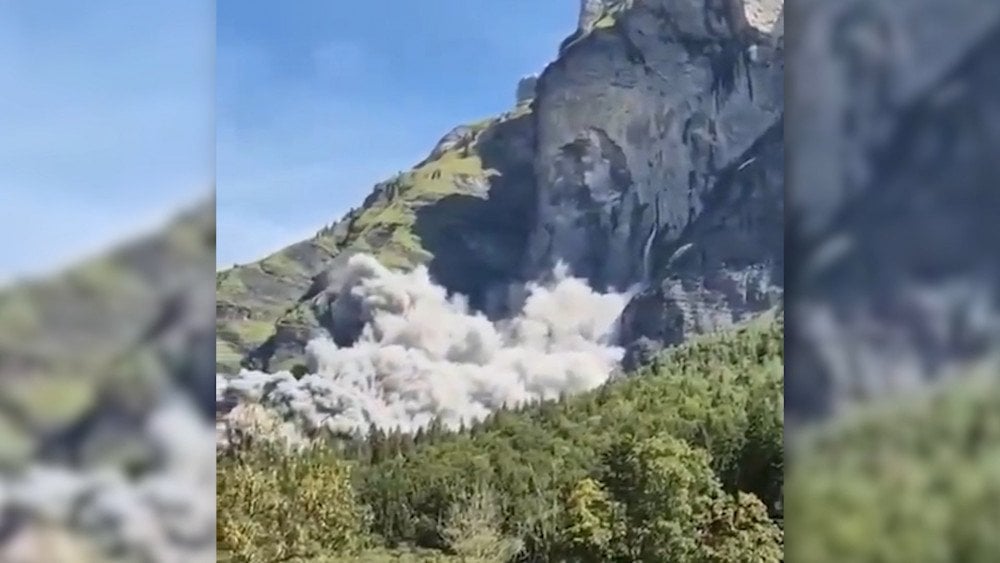
A rockfall from the slopes of the Sixt-Fer-à-Cheval mountain range raised a cloud of dust over the Giffre Valley in the Haute-Savoie department, France
According to geomorphologist and researcher Ludovic Ravanel, the volume of the collapse reached 30,000–40,000 m³ — a record figure for this region.
Sixt-Fer-à-Cheval — a natural amphitheater (“Cirque du Fer-à-Cheval”) in the shape of a horseshoe — is listed as a French heritage site and attracts about 500,000 visitors annually.
Although rockfalls often occur on the steep slopes of Sixt-Fer-à-Cheval, such a massive collapse at an altitude of 1,300 m (4,265 ft) is a true rarity.
In Earth’s atmosphere, both kinetic and potential energy are increasing. Kinetic energy is directly linked to the movement of air masses. It is the energy of winds, cyclones, hurricanes, tornadoes, and other dynamic processes. The higher the wind speed, the greater the energy. This is why eyewitnesses increasingly note that no one has ever seen nature’s fury on such a scale before.
Japan
On September 5, Typhoon Peipah struck Japan. It rapidly intensified after merging with powerful rain clouds, triggering extreme weather conditions — hurricane-force winds and record-breaking downpours.
In Shizuoka Prefecture, rainfall reached exceptional levels: in Kakegawa — 120 mm/h (4.7 in/h), and in Yoshida — up to 110 mm/h (4.3 in/h).
In Makinohara, water levels at the airport parking lot reached one meter (3.3 ft), flooding around 300 cars. The city was also hit by a powerful tornado that left a 7 km (4.3 mi) long and 500 m (1,640 ft) wide trail of destruction.
In Yoshida, which also came under impact, the whirlwind overturned a car in a parking lot. The driver was rushed to the hospital but later died from injuries.
The tornado was so strong that it deformed steel structures of buildings. Experts rated it as Category 3 on the Japanese Modified Fujita Scale.
As a result of Typhoon Peipah, more than 1,300 buildings were damaged. Widespread power outages affected over 10,000 households. The situation was worsened by sweltering heat that gripped the region.
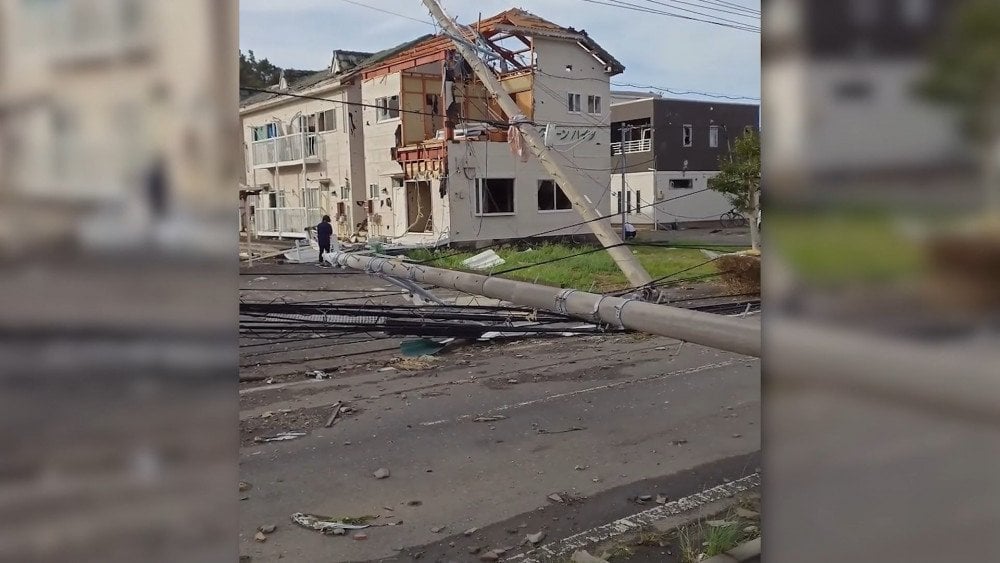
A tornado triggered by Typhoon Peipah caused severe destruction in Yoshida, Shizuoka Prefecture, Japan
In Shizuoka Prefecture, 89 people were injured, 8 of them seriously.
The potential energy of the atmosphere is stored in the vertical positioning of air masses and in the latent heat linked to phase transitions of water.
Disruption of this energy balance leads to unprecedented weather anomalies worldwide. This is exactly what we are witnessing now. Rainfall becomes extreme — a year’s worth of precipitation falls within just hours, and hail grows to giant sizes.
India
Northern India has been under the grip of devastating monsoon rains for more than a month. The hardest-hit states are Punjab, Uttarakhand, Himachal Pradesh, Jammu and Kashmir. The aftermath of the disaster has been catastrophic: homes were flooded, several national highways cut off, more than 1,200 roads closed, and railway traffic paralyzed.
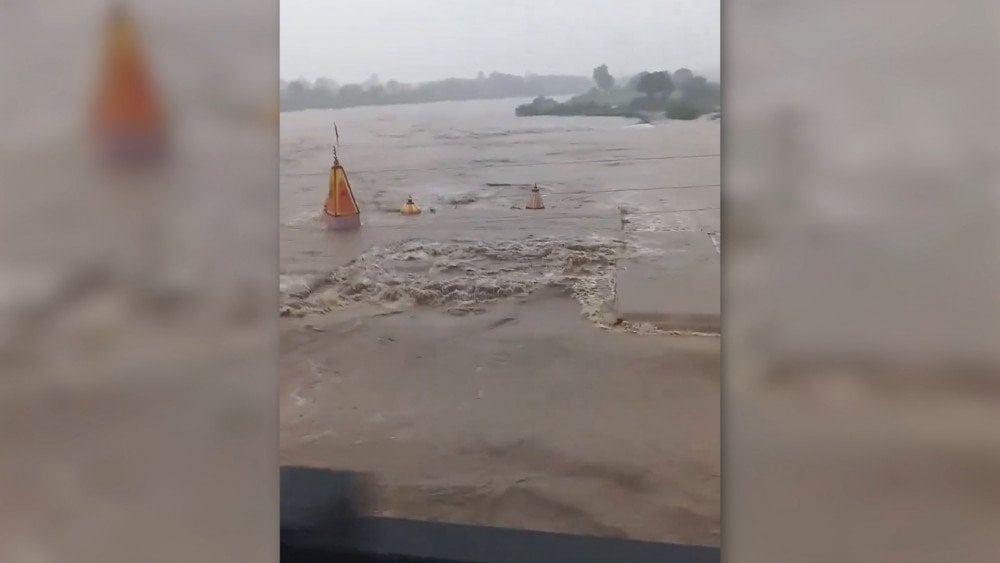
In India, the overflowing Chambal River almost completely submerged a temple near the city of Nagda, Madhya Pradesh
In Punjab, with a population of more than 30 million people, the worst flooding since 1988 occurred: all 23 districts of the state were declared disaster zones.
In the catchment basin of the Pong Dam, the highest rainfall ever recorded was reported. The previous record was set in 1988, when 7.9 billion cubic meters of water entered the dam; in 2025, this number rose to 11.7 billion.
Around 2,000 villages were flooded. People were forced to seek refuge on the rooftops of their homes.
Hundreds of thousands of residents were left without electricity and clean water. Enormous damage was inflicted on agriculture — more than 170,000 hectares (420,000 acres) of crops were destroyed, and vast numbers of livestock perished.
Punjab is one of the country’s main producers of rice and wheat. But the fields where these crops usually grow have turned into stretches of water, and the air was filled with the stench of decomposing animal carcasses.
On September 5, the Ravi River washed away about a hundred border posts and destroyed 30 km (19 mi) of fencing along the border with Pakistan.
That same day in Himachal Pradesh, in the Inner Akhara Bazar area of Kullu, a sudden landslide destroyed three houses. One person died and three were injured.
In India’s capital, Delhi, the Yamuna River rose above the critical mark — about 18,000 residents were evacuated from low-lying areas.

Indian streets went underwater, forcing residents to move around by boat
As of September 7, since the beginning of the monsoon season in Northern India, floods and landslides have already claimed the lives of more than 500 people.
Hail
Last week, thunderstorms with large hail were recorded around the world.
In Kansas, USA, on September 3, eyewitnesses shared photos of hailstones measuring 7–8 cm (2.7–3.1 in), which damaged roofs, vehicles, and farmland.
And on September 8, in Clark County, hailstones over 10 cm (3.9 in) in diameter fell.
On the same day in southern Poland, in the town of Żywiec, Silesian Voivodeship, hail up to 4 cm (1.6 in) in size stripped leaves and broke branches from trees.
On September 5, in the settlement of Khurba, Khabarovsk Krai, Russia, ice stones the size of a chicken egg fell from the sky.

Unusually large hail fell in the settlement of Khurba, Khabarovsk Krai, Russia
And in the city of Komsomolsk-on-Amur, hail poured for an hour, creating a solid cover on the ground and dangerous conditions for drivers.
It is important to note that in the atmosphere, not only kinetic and potential energy are increasing, but also the amount of electrical energy, which has a significant impact on the planetary system.
Lightning
On September 2–3, dry thunderstorms struck Central California, USA. Thousands of lightning strikes ignited numerous wildfires.
The TCU September Lightning Complex fire broke out on September 2, burning more than 5,665 ha (14,000 acres) across Tuolumne, Calaveras, and Stanislaus counties. The blaze destroyed 95 structures, including a historic landmark from the Gold Rush era — the post office in the town of Chinese Camp.
More than a thousand homes came under threat of destruction, and hundreds of residents had to be evacuated.
Despite massive firefighting resources, it took four days to achieve 50% containment of the fire front.
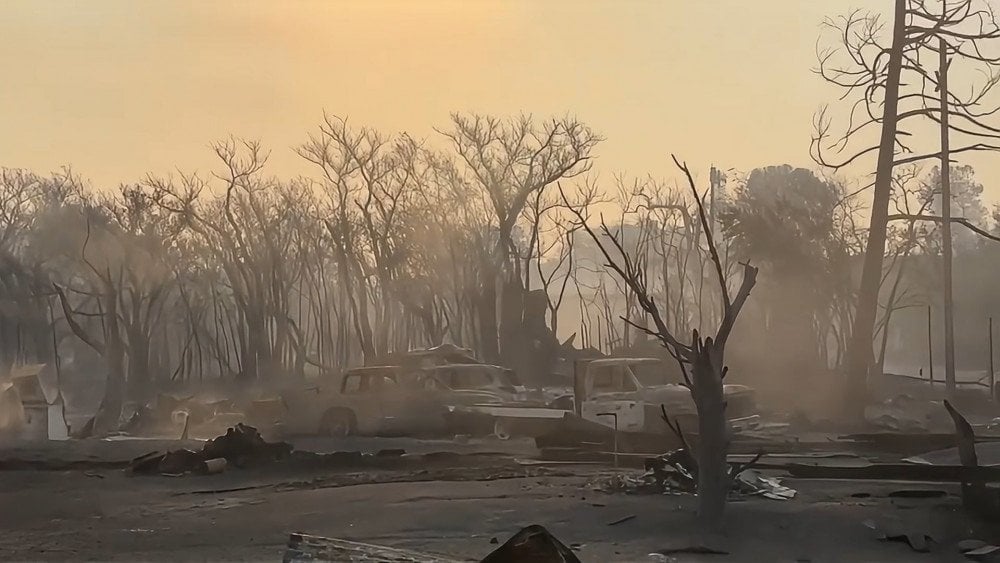
Aftermath of destructive lightning-caused wildfires in California, USA
In early September, Canada was also hit by lightning. After warm and dry weather created ideal conditions for fire spread, storms in British Columbia triggered several large forest fires.
On September 4, about 15,000 lightning flashes were recorded in Switzerland. In Lucerne, one struck a house, igniting its roof. Fortunately, the fire was quickly extinguished.
On September 7 in Visakhapatnam, a major port in India, lightning struck a tanker loaded with highly flammable methanol, sparking a massive fire.
It took a full day to extinguish the blaze: dozens of firefighters, the military, and a helicopter were involved. Torrential rains played a decisive role — they prevented the flames from spreading to four nearby diesel tanks, helping avoid a far greater catastrophe.
India is one of the countries where lightning frequency is rising most rapidly. Over the last 5 years, lightning strikes have nearly quadrupled: in the 2020 fiscal year there were 5.17 million, while in 2025 there have been more than 20 million so far.
Mortality from lightning strikes, long a serious issue in the country, has now reached catastrophic levels: between April and July 2025 alone, 1,621 people died.
On September 8–9, Australia was hit by anomalous thunderstorms. In the desert regions of Birdsville and Cameron Corner, a record 466,000 lightning strikes were recorded within 36 hours.
Winds reached 117 km/h (73 mph), and rainfall exceeded the monthly norm. Such a combination of weather conditions is highly unusual for September: this month is traditionally dry, and large-scale thunderstorms are extremely rare in this region.
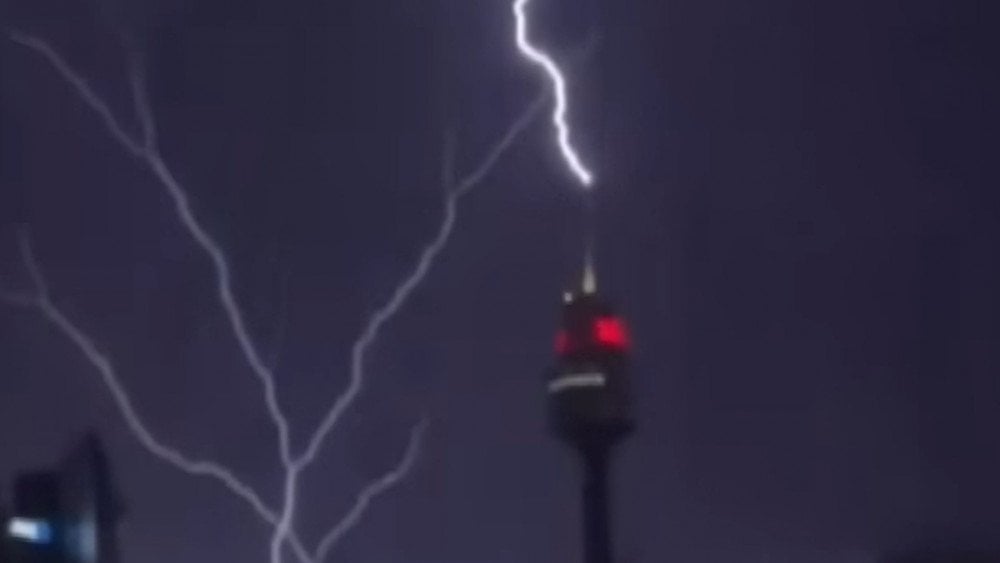
An incredibly powerful thunderstorm struck Sydney, Australia
Birdsville (Queensland) and Cameron Corner (at the border of Queensland, South Australia, and New South Wales) are located in Australia’s arid zones. Typically, they experience dry weather most of the year, and thunderstorms occur occasionally, mostly in summer (December–February).
Sprites
There has also been an increase in reports of rare and little-studied atmospheric phenomena known as sprites. These are enormous glowing red formations that appear above thunderstorm clouds and extend to altitudes of 40–80 km (25–50 mi).
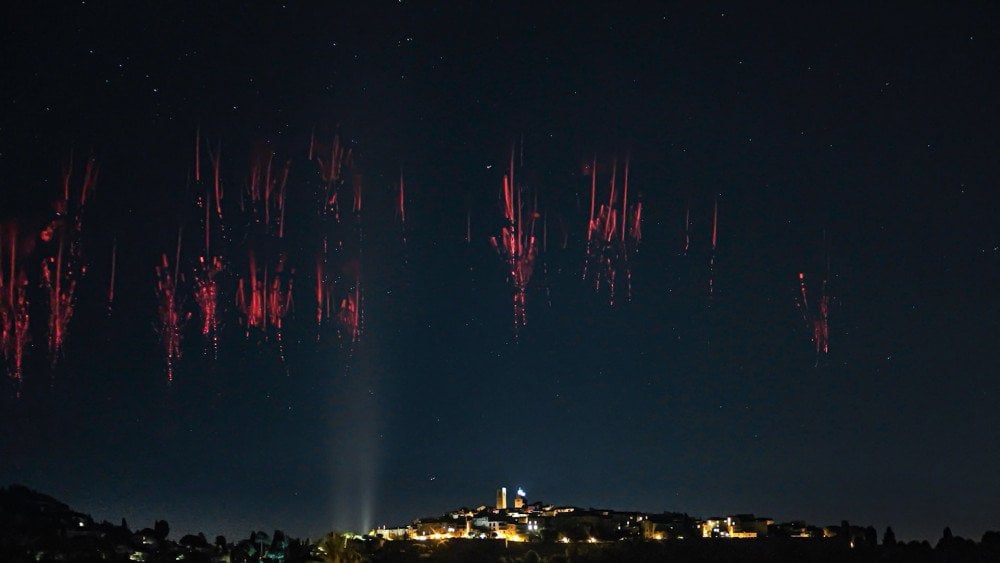
Rare red sprites — little-studied luminous formations in the upper layers of the atmosphere
According to a study published in the journal Atmospheric Chemistry and Physics, the frequency of sprites may increase by about 14% for every degree of global temperature rise.
Arctic
Despite all attempts to divert public attention from the problem of the Siberian plume, its manifestations are becoming so evident that hiding them is no longer possible. August in the Arctic became the warmest on record. Average monthly temperatures on the islands and coasts of the Barents, Kara, and East Siberian Seas, as well as in Greenland, exceeded the norm by 2–6 °C (3.6–10.8 °F) and more.
But it is in the Russian Arctic that the situation looks especially alarming: here in August 2025 the world’s highest positive temperature anomaly for that month was recorded.
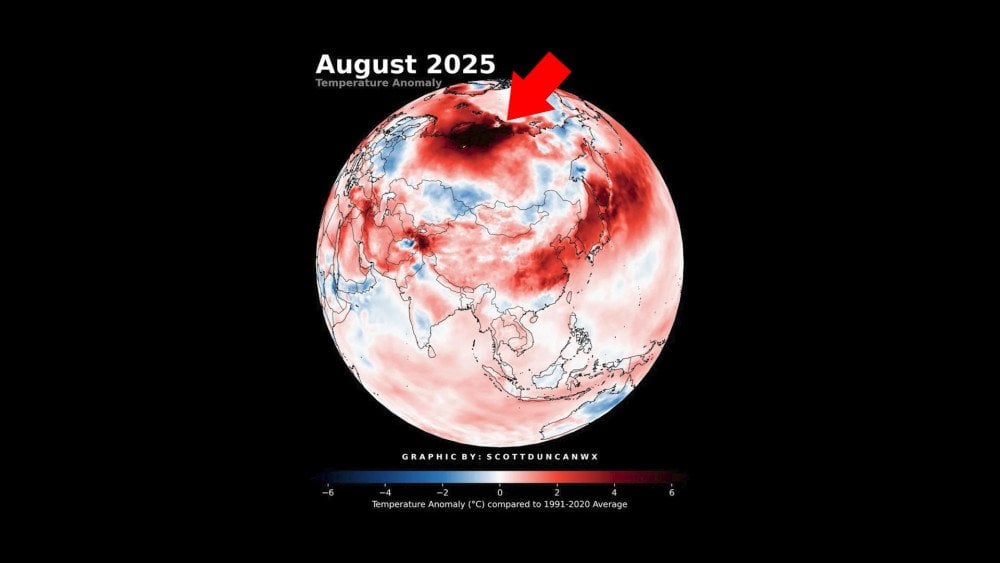
August 2025: the Russian Arctic experiences unprecedented warming — the impact of the Siberian plume is becoming ever more pronounced
The Siberian mantle plume is also a powerful source of thermal energy, expressed, in particular, through direct heating of the Earth’s crust and thermal impact on near-surface layers.
In the current 12,000-year disaster cycle, energy is accumulating exponentially in Earth’s atmosphere through multiple mechanisms. The trigger is external cosmic influence on the planet’s core, launching a cascade of energetic processes in all its layers.
Previously, thermal energy moved from the planet’s interior into the ocean, then into the atmosphere, and further into space — a process that worked like clockwork. Now it is disrupted: energy that should have escaped into space remains “trapped” in the atmosphere.
The atmosphere has become a kind of energy capacitor due to its enormous content of nanoplastic. We will speak in more detail in the upcoming issues about the destructive properties of plastic, which harm human health and our planet as a whole, but we already encourage you to explore this crucial topic now.
People must understand the causes of what is happening and realize what measures are necessary for humanity’s survival.
This is not about a future generation — we ourselves will have to face the consequences.
To preserve our tomorrow — we must act today.
Leave a comment